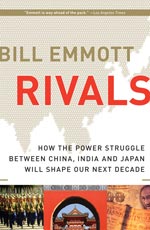
Rivals: How the Power Struggle Between China, India and Japan Will Shape Our Next Decade
by Bill Emmott
In his book on the next big era of global politics, Bill Emmott makes a salient point: “The world was lucky that Osama bin Laden had set up his al-Qaeda headquarters in Afghanistan rather than in North Korea, Myanmar or Pakistan.”
That is, the two wars of the last seven years, despite “terrorism, instability and a lot of name-calling,” did not involve rival powers on opposite sides, such as China or India against the U.S. And thanks to high oil and commodity prices, the wars didn’t stop most of the world from going right along pursuing economic growth, including the three countries that Emmott says are in line to challenge the U.S.’s superpower mantle: China, India and Japan. The story of these three countries is likely to be the story of the next century, Emmott argues, and the U.S. and Europe need to know what part to play.
What Asia is to the 21st century, Europe was to the 19th: a “rising, scratchy, aspirational and at times unstable” group of neighbors with tenuous loyalties and dangerous rivalries. The “Concert of Europe” held the peace for a century but was bookended by brutal wars. Thankfully, the Asian century may not proceed quite as the European one did, Emmott explains.
He runs through the frightening list of “flash points” between the Asian countries: the unstable Korean peninsula, Japan and China’s conflicting territorial claims, India and China’s skirmishes over land at the mountainous border they share, and Pakistan’s instability. But, barring war by a big power miscalculation or a smaller country’s accident, hot conflict is less likely in this century than the last two, thanks to the nuclear power of several Asian countries, public opinion, international law, and instant communication. (Though, as Emmott notes, communication between Asian countries and the U.S. aren’t anywhere as good as those between the U.S. and the Soviet Union during the Cold War.)
And so, Rivals focuses not on the prospect of war and its prevention, but on how China, India and Japan may capitalize on their moment without hot war, even if they can’t help but be rivals, and how the U.S. and Europe can encourage their peaceful growth and participation in world institutions. Each of the Asian powers has its challenges, as Emmott notes in his dense but easily read economic analyses – whether China can sustain its radical pace of growth and keep its political system functioning; whether India can improve its education, infrastructure and bureaucracy; and whether Japan can keep growing with its aging population.
The rest of the world, too, has a challenging task when it comes to handling Asia’s rise. Emmott’s recommendations for the U.S. seem impossibly daunting, including revamping global institutions to include the rivals (presumably a diplomatic nightmare), negotiating a new nuclear nonproliferation treaty, taking major emissions cuts, helping mend the long-lasting wounds of World War II (not to mention rethinking the Tokyo trial that still circumscribes Japan’s military policy). But, reasonably, Emmott doesn’t anticipate how it’s all going to work out. Instead, he offers both pessimistic and optimistic predictions, and concludes that either way it “is going to be quite an adventure.”
Excerpt: “Would a Chinese state-owned firm be allowed to buy Nippon Steel, say, or Toshiba? Or a prominent Indian firm? You can bet your bottom renminbi that it would not be. China, India and Japan are rivals. They have good reason to be suspicious and jealous of one another.”
Further Reading: The New Asian Hemisphere: The Irresistible Shift of Global Power to the East and The Post-American World




Send A Letter To the Editors